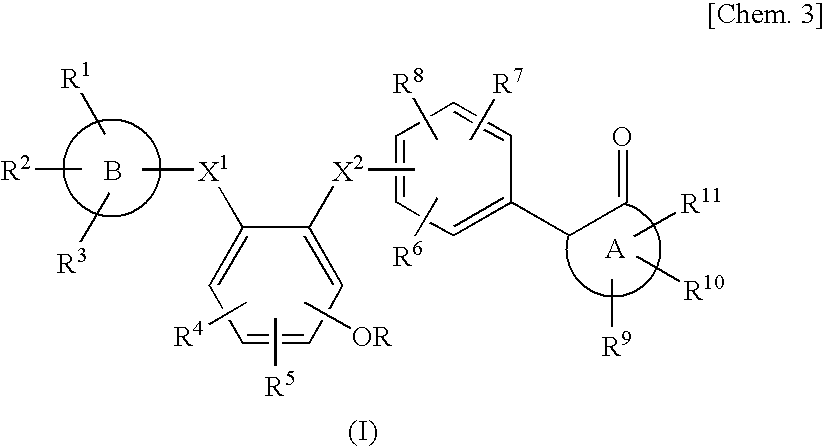Benzene derivative or salt thereof
a technology of benzene derivatives and derivatives, applied in the field of benzene derivatives, can solve the problems of difficult control and extremely difficult use of drugs in clinics, and achieve the effect of strong anticoagulation activity and preventing infection
- Summary
- Abstract
- Description
- Claims
- Application Information
AI Technical Summary
Benefits of technology
Problems solved by technology
Method used
Image
Examples
reference example 1
[0085]3-Bromo-1-methylpyridin-4(1H)-one hydrobromide (640 mg) was suspended in toluene (10 ml) and water (5 ml), and [4-(methoxycarbonyl)phenyl]boronic acid (642 mg), sodium carbonate (757 mg) and tetrakis(triphenylphosphine)palladium(0) (138 mg) were added, followed by stirring under heating in an oil bath at 100° C. for 3 hours. The reaction mixture was filtered through Celite, followed by extraction with ethyl acetate. The organic layer was concentrated under reduced pressure, and the residue was purified by silica gel column chromatography (FUJI SILYSIA CHEMICAL Ltd., the same shall apply hereinunder) (chloroform:methanol=90:10) to obtain methyl 4-(1-methyl-4-oxo-1,4-dihydropyridin-3-yl)benzoate (118 mg).
[0086]In the same manner as in Reference Example 1, compounds of Reference Examples 4, 7, 10, 12, 14, 16, 18, 119, 132 were obtained.
reference example 2
[0087]1 M NaOH (1.42 ml) was added to an EtOH suspension (3 ml) of methyl 4-(1-methyl-4-oxo-1,4-dihydropyridin-3-yl)benzoate (115 mg), followed by stirring at room temperature for 8 hours. 1 M HCl (1.42 ml) was added to the reaction solution, followed by concentration under reduced pressure. Water (20 ml) was added to the residue, followed by stirring for 20 minutes. The precipitate formed was collected by filtration and dried under reduced pressure at 60° C. to obtain 4-(1-methyl-4-oxo-1,4-dihydropyridin-3-yl)benzoic acid (92 mg).
[0088]In the same manner as in Reference Example 2, compounds of Reference Examples of 5, 9, 17, 22, 24, 31, 33, 34, 36, 38, 40, 42, 44, 46, 48, 50, 52, 54, 56, 58, 60, 62, 64, 66, 68, 70, 72, 74, 76, 78, 80, 82, 84, 85, 87, 89, 91, 93, 95, 97, 99, 101, 103, 105, 107, 109, 111, 113, 115, 117, 120, 123, 125, 127, 129, 133 were obtained.
reference example 3
[0089]5-Bromopyrimidin-4(3H)-one (578 mg) was dissolved in N,N-dimethylformamide (15 mL), and potassium carbonate (685 mg) and methyl iodide (247 μL) were added, followed by stirring at room temperature for 24 hours. Water was added to the reaction mixture, followed by extraction with chloroform. The organic layer was washed with saturated brine and dried over anhydrous sodium sulfate. The solvent was evaporated under reduced pressure, and the resulting residue was purified by silica gel column chromatography (hexane:ethyl acetate=1:1) to obtain 5-bromo-3-methylpyrimidin-4(3H)-one (337 mg) as a white solid.
PUM
| Property | Measurement | Unit |
|---|---|---|
| pH | aaaaa | aaaaa |
| body weight | aaaaa | aaaaa |
| volume | aaaaa | aaaaa |
Abstract
Description
Claims
Application Information
 Login to View More
Login to View More - R&D
- Intellectual Property
- Life Sciences
- Materials
- Tech Scout
- Unparalleled Data Quality
- Higher Quality Content
- 60% Fewer Hallucinations
Browse by: Latest US Patents, China's latest patents, Technical Efficacy Thesaurus, Application Domain, Technology Topic, Popular Technical Reports.
© 2025 PatSnap. All rights reserved.Legal|Privacy policy|Modern Slavery Act Transparency Statement|Sitemap|About US| Contact US: help@patsnap.com



